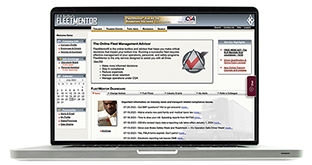Sr. Transportation Management Editor — J. J. Keller & Associates, Inc.
The Right Fleet Management Tools for the Job
Here are three critical components of a successful fleet management program.
Published On: 12/19/2024


Written by:
Mark Schedler
Creating Your Employee Handbook
One of the tools of fleet management is an employee handbook that communicates company policy regarding topics such as:
- Job descriptions and role responsibilities
- Dispatch operations
- Vehicle inspections
- Hours-of service and electronic log use
- Company speed limits
- Post-accident requirements
- Open door policy
- Drug and alcohol requirements
- Items that are prohibited in the vehicle
All employees want to know what is expected of them, what is acceptable and what is not, and what will either keep them employed or end their employment. Everyone’s role and the accompanying responsibilities must be well understood by all employees, not just drivers.
Driver Hiring & Qualification
A great team results from hiring people with the right qualifications and most importantly — people who share your company values. Setting and maintaining your hiring standards is easy to say, but harder to do when qualified potential employees are scarce. However, the quality of your organization is directly determined by the quality of people you choose to join your team.
FMCSA stresses that driver qualification processes must be followed precisely as there are several steps with multiple requirements. It is also imperative to ensure that your drivers are always qualified when operating your commercial motor vehicles (CMVs).
If you manage this process from spreadsheets or paper only, you may not have enough hours in a day to stay current on every driver. An electronic tickler process or system that allows you to stay on top of every aspect of driver qualification and hiring makes this daunting task very manageable.
Training
Another tool is training. Training can be viewed as a means of communication to get desired results. Effectively leading and motivating a workforce is a responsibility for transportation leaders and dispatchers. These results can best be accomplished when dispatchers can understand their job responsibilities, what the drivers are dealing with, as well as the company and regulatory requirements. Consequently, any training and testing that drivers are exposed to should also be shared with dispatchers and others working with drivers as appropriate. A formal training program with a broad library of topics presented both on a regular basis and as impromptu corrective action is a foundational element of any successful safety program.
For dispatchers, communicating with drivers in a manner that engenders cooperation and reliability can be a challenge. When employees receive regular training, dispatchers are empowered to devise solutions to satisfy business needs and generates more job satisfaction. Drivers want to know that their support team is capable and there to help when needed.
Training is essential to building that confidence in everyone on the team. If a carrier relegates most training to on-the-job, trial-by-fire training instead of formal training, it will be a barrier for drivers to be confident in the company and more difficult to optimize driver performance.

J. J. Keller® FleetMentor® Service
The J. J. Keller® FleetMentor® System serves and supports thousands of transportation professionals every day with problem-solving tools and guidance. Whether you have one truck or a thousand, a fleet of commercial motor vehicles or F-150s, or haul goods or provide services — FleetMentor has you covered.
You may also enjoy the following articles:
Sign up for our newsletter!
We'll help you stay on top of regulations, best practices, and fleet industry news. Sign up to receive a monthly email notification with links to our most recent blog articles, free resources, and event invites.